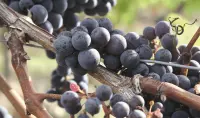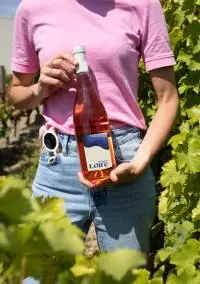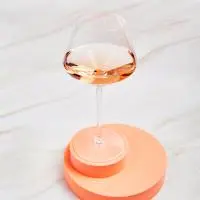Rosés
Rosés

How is rosé wine made?
Ah, rosé wine... That delicious blend of lightness and freshness, sipped both as an aperitif and on a terrace in the summer sunshine. But that's not all! Rosés are the perfect allies to enhance our meals all year round. But how do you get that pretty pink color? The answer lies in the winemaking process!
Two main techniques bring out rosé's subtle nuances.
First, direct pressing: a gentle method where grapes are pressed quickly to extract barely tinted juice, producing a clear, delicate rosé. The second option, saignée, involves letting the grapes macerate for a short period, capturing more color and aromatic richness. The result is a rosé with more intense aromas and deeper color.
Our tips for choosing a Loire rosé wine
Freshness, gourmandise, elegance, lightness and vivacity, so many reasons to choose a rosé from the Loire to accompany a moment of sharing around a table.
The Loire, France's second-largest rosé wine-producing region, invites you on a veritable oenological stroll.
Your journey begins with the unmissable Cabernet d'Anjou, with its luminous charm. An attractive color, between rosewood and subtle rose nuances, and reveals a fruity nose of strawberry, redcurrant and English candy. Round and smooth on the palate, with a refreshing finish. We particularly like it with world cuisine, this wine working perfectly with Asian cuisine in particular.
Then we pause for a moment to consider the Rosé d'Anjou, a wine all in harmony. With its luminous, crystal-clear color, freshness and lightness are the order of the day, with aromas of red fruits such as raspberry and redcurrant, punctuated by mentholated notes on the finish. It's the rosé of choice for your summer evenings, and will do its job as an aperitif with as much brio as a white wine from the Loire.
A little further north, in the vicinity of Touraine, Loire rosé wine is adorned with new colors and new flavors. The rosés in the Touraine appellation, made from a blend often composed of Gamay, Cabernet Franc and sometimes evenPineau d'Aunis, offer a tart freshness that will delight lovers of light, fruity wine. With its pale pink color and aromas of strawberry, raspberry and violet, the Touraine Noble-Joué is emblematic of this terroir.
Directing to the Saumur region, the Saumur rosé, although produced in smaller quantities, has nothing to be ashamed of in terms of its character. It's a lively wine, marked by aromas of red berries, that oscillates between sweetness and freshness. It is available in sparkling rosé, a delicate, fine-bubble version.
The Coteaux d'Ancenis, meanwhile, offers light, discreet rosés with a fruity taste that lends itself to accompanying a barbecue. The Coteaux du Loir is an appellation to (re)discover in rosé form, with its emblematic grape variety, Pineau d'Aunis, adding a unique spicy, peppery touch.

How do you pair Loire rosé wines with food?
With Loire rosés, the perfect match is easy to find. Quite simply, they adapt to every situation. With a Cabernet d'Anjou, for example, you can dare unexpected associations. This rosé wine from the Loire region goes perfectly with Asian specialties... tuna maki, Peking duck or beef with onions, any combination is possible. But it also knows how to adapt to the flagships of French cuisine, like a roasted chicken or a chocolate fondant. It's that table companion that never lacks freshness.
The Rosé d'Anjou, meanwhile, lifts up everyday cooking with a touch of elegance and plenty of authenticity. It's the perfect accompaniment to tapas or an exotic salad in summer, as well as a homemade burger. Its tangy freshness also lends itself to elaborate dishes, such as black pudding with apples or jam rolls.
A getaway to Touraine will open up new perspectives. Impossible to resist aperitif pairings, which put rosé de Touraine at the center of the table. Eggplant caviar on toast, salmon rillettes, light charcuterie: it's up to you to find the right combination. Further west, the Coteaux d'Ancenis, will be the perfect ally to enhance grilled meats, as will the rosé de Saumur which will freshly underline skewers and crudités.
What are the emblematic grape varieties of rosé wines?
When we talk about rosé in the Loire, we of course think of Cabernet Franc, which is the beating heart of the rosés of Anjou and Touraine. It's appreciated for its finesse and fruitiness, producing balanced, pleasing wines. The Grolleau, a grape variety all about roundness and fruitiness, produces supple, easy-drinking rosés, perfect for lovers of simplicity. The rarer Pineau d'Aunis expresses itself in rosés with a spicy, peppery character, found more widely in the Coteaux du Loir.

How to serve Loire rosé wine
It's always a good idea to serve Loire rosés well chilled, at around 8 to 12°C, to preserve their liveliness and aromas. The temptation is great to keep them in the fridge: it's better to find a place for them in a wine cellar to avoid any alteration of the aromas. To reach the ideal temperature, you can chill your rosé an hour before serving.
How well does rosé wine age?
Like love, rosé has no age... but it all depends on the wine! Some, like Touraine Noble-Joué, are made to be enjoyed young, to capture all their freshness and vivacity. But others, like the Cabernet d'Anjou, may hold surprises about their ageing potential. While, on the whole, we advise savoring rosés in their youth, some generous vintages know how to improve with time, like red wines. A Cabernet d'Anjou matures with elegance and reserves aromatic surprises after several decades.
Can Loire rosé wine be served in all seasons?
Absolutely! While rosé often evokes summer and sunny terraces, it's not reserved for the summer months. Its freshness and fruitiness make it an excellent companion for many occasions, whatever the weather. In spring or autumn, it goes wonderfully well with hearty salads and light grilled meats. In winter, you'll be amazed at the perfect harmony it creates with foie gras with figs or duck with orange. Rosé de Loire is made to surprise and seduce you through the seasons!
